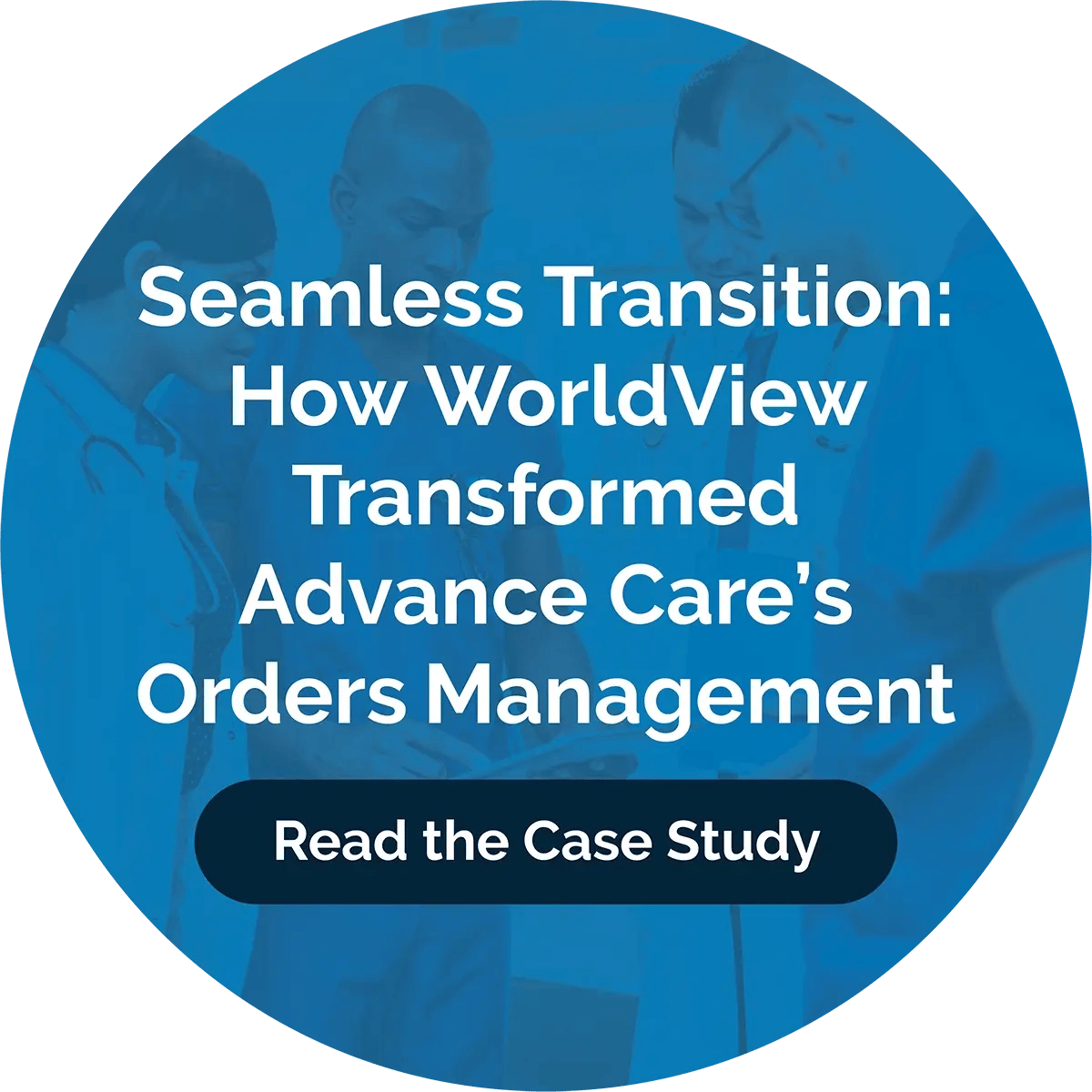What Makes Home Health Care Documentation Unique

While sharing similarities with other medical fields, home health has its own distinct characteristics that make clinical documentation essential for quality care. The in-home setting means close attention must be paid to compliance and confidentiality.
In addition, providers must meticulously document each component of patient care to ensure agencies receive maximum reimbursement under the value-based purchasing model. Whether the aim is to maximize home health agency (HHA) profitability or improve patient outcomes, effective clinical documentation is a must — and so is the software that powers it.
In this guide, we'll explore the state of home health in 2024 and what makes home health documentation unique. We'll also look at the role of document management in home health and offer strategies for optimizing document management solutions, such as WorldView, within organizations.
The State of Home Health in 2024
Several changes are on the horizon in the home health industry for 2024, with some already in effect. Here are a few key changes in home health in 2024:
- The Centers for Medicare and Medicaid Services (CMS) issued their calendar year home health prospective payment system (CY 24 HH PPS), estimating that reimbursement rates will increase by 0.8%, totalling $140 million.
- The CMS finalized multiple amendments to their HH Quality Reporting Program, introducing a new metric to calculate the percentage of home health patients who are up-to-date with COVID-19 vaccinations.
- The CMS continues its transition to the Home Health Value-Based Purchasing (HHVBP) model, where reimbursement rates are determined by patient care outcomes.
These recent changes highlight the importance of prioritizing the delivery of quality care to promote patient well-being. Organizations that consistently provide quality care will be rewarded with greater reimbursements.
Essential Documentation for Home Health Organizations
Unlike traditional healthcare settings where a team of medical professionals attends to a patient, home health often involves a single provider interacting with the patient. This makes thorough documentation even more critical, as errors may easily go unnoticed without a second team member reviewing the records.
Home health providers must ensure that patient records are accurate, current, and complete. Regulation 42 CFR 484.110 provides a comprehensive overview of the specific requirements for maintaining medical records. A patient's medical record should include the following core components:
- Current comprehensive assessment data
- List of interventions, including medications, treatments, and services, along with the patient's response to these interventions
- Goals in the patient's care plan
- Contact information of the patient, patient's representatives, and primary caregivers
Failure to maintain accurate and complete patient information can have negative consequences, such as poor patient outcomes and compliance violations. For instance, incomplete health data could disrupt care during transitions. This kind of documentation oversight could damage an agency's bottom line since the HHVBP model ties reimbursement rates to patient care outcomes.
Unique Aspects of Home Health Documentation
Documentation can be challenging in home health because care is delivered at the patient's home. While other care facilities utilize electronic health records (EHR), home health providers may sometimes rely on basic documentation tools like spreadsheets or paper charts. These tools can be inefficient and prone to errors.
Legacy systems are often vulnerable to data breaches, and manual paperwork is time-consuming and susceptible to data omissions due to improper note formatting.
Employing outdated solutions can result in reduced efficiency, greater provider workload and subsequent burnout, and inadequate reporting of patient care. These factors can significantly impact patient outcomes, thereby negatively affecting revenue.
Leveraging Document Management Solutions
Document management solutions can help alleviate many of the stresses home health providers experience due to outdated documentation processes. These tools offer functionalities that can streamline provider workflows and help caregivers deliver optimal care to their patients, including:
- A standardized documentation system that ensures compliance with relevant regulations (HIPAA, HITECH, etc.)
- An automated data entry process to increase efficiency and reduce errors
- Image-capturing features to display wound status or other essential visuals
- Electronic signature processing
- Cloud-based storage for quick file transfer and data security
- Interoperability with other EHR systems
Home health document management solutions can reduce the likelihood of oversights and empower clinicians to offer the best possible care to their patients. They also enable providers to easily identify patients' needs and prescribe orders for home health services more accurately.
The result is fewer denials, payment delays, and violations and higher reimbursement rates, all while simplifying documentation workflows and capturing data in real-time. By delivering a centralized hub for efficiently managing each patient's medical needs, WorldView's document management solutions can help HHAs solve their most pressing challenges.
The Role of Document Management Providers in Home Health
HHAs that have transitioned to document management solutions have experienced multiple benefits across their operations.
One case study shows how an HHA switched to WorldView's document management system and reduced its provider workload. Previously, they allocated one full-time and three part-time employees to fulfill document-related tasks. Despite the number of personnel, the agency experienced significant delays in accessing medical records. With WorldView's software, they were able to reduce their number of data entry specialists to one full-time employee and enhance accessibility to medical records through an automated data entry system.
Less overhead, fewer data errors, and faster access to records — these are some of the benefits document management solutions provide. Each of these improvements can enhance an HHA's patient outcomes and profitability.
Conclusion
In home health care, the home serves as the primary location for care delivery, which underscores the need for HHAs to have a documentation solution capable of adapting to each patient's unique environment. These solutions must offer versatile functionalities to accommodate a wide range of patient conditions while remaining intuitive enough for providers to easily use them for point-of-care charting. Utilizing an ineffective documentation solution could result in poor delivery of care, negatively impacting patients' health and an organization's revenue.
At WorldView, we provide an all-in-one home health document management solution that empowers providers to deliver top-notch patient care. With our software, clinicians can write their patients' care plans, take confidential images of wounds and other health data, and utilize e-signatures to approve prescriptions and other important documentation.
WorldView's document management software delivers a centralized hub that facilitates each component of your home health operations, improving patient care in the process. Schedule a demo today to see how we can help your organization.
Blog Post Tags
BusinessGet Awesome Content Delivered Straight to Your Inbox!
Posts by topic
- Healthcare
- Business
- AI
- Hospice
- AP Workflows
- Home Care Management
- hospice-care
- General
- Industry Insights
- agency
- Blog
- Commercial
- reporting
- Data Analytics
- billing
- referrals
- News
- Referral AI
- business goals
- Operations
- business development
- partners
- Integration
- Healthcare Trends
- leadership
- Medicare
- Compliance
- audit
- medicaid
- Better Charting
- regulations
- Application
- Automation
- finance
- CRM
- DMSi
- Events
- KanTime
- Press Release
- Revenue Growth
- Announcements
- Artificial Intelligence
- EHR
- ESign
- Guides
- Homecare Homebase
- Mobile
- Physician Order Tracking
- axxess
- clinical
- interoperability
- payor See All See Less


.png?width=596&name=WV%20Hc%20Clinical%201%20Web%20(3).png)
.png?width=596&name=WV%20Hc%20Clinical%201%20Web%20(2).png)
.png?width=596&name=WV%20Hc%20Clinical%201%20Web%20(5).png)